Author: jaehaerys
Compilation: Felix, PANews
Key points:
What is the Succinct Prover Network? It is a decentralized zero-knowledge (ZK) proof generation market based on Ethereum, aimed at connecting requesters needing ZK (such as Rollups, bridges, and AI applications) with a global network of computing power providers (provers).
How does it work? The network adopts a vApp architecture. A fast off-chain auction service manages the auctions in real time, while the security of the funds and final settlement is ensured by smart contracts on Ethereum, combining the performance of Web2 with the security of Web3.
What is the role of the $PROVE token? The $PROVE token (ERC-20) is the economic core of the network, with three main functions:
Payments: The only token used to pay for proof generation fees.
Security: Validators must use $PROVE as collateral; if misconduct occurs, the collateral may be slashed.
Governance: Token holders vote on key protocol parameters. The initial supply is 1 billion, and its issuance rate is controlled by governance.
How does the market operate? Requesters submit tasks, and provers compete to fulfill these tasks through reverse auctions, with the lowest bidder winning. This mechanism ensures competitive pricing for proofs.
What are its core advantages? (Ecosystem) Succinct has established partnerships with many major Web3 projects, addressing the cold start problem by ensuring significant demand for network services from day one.
1. Introduction
The narrative landscape of Web3 is undergoing a significant shift, with zero-knowledge technology rapidly rising to become a hot topic. Once just a niche academic concept, it has now gained widespread attention from developers and the market, ranking in the top three in terms of industry focus alongside AI and DeFi. This surge in relevance is driven by a clear trend: ZK-based applications are maturing, and ZK proofs are being strategically integrated into the core of blockchain infrastructure.
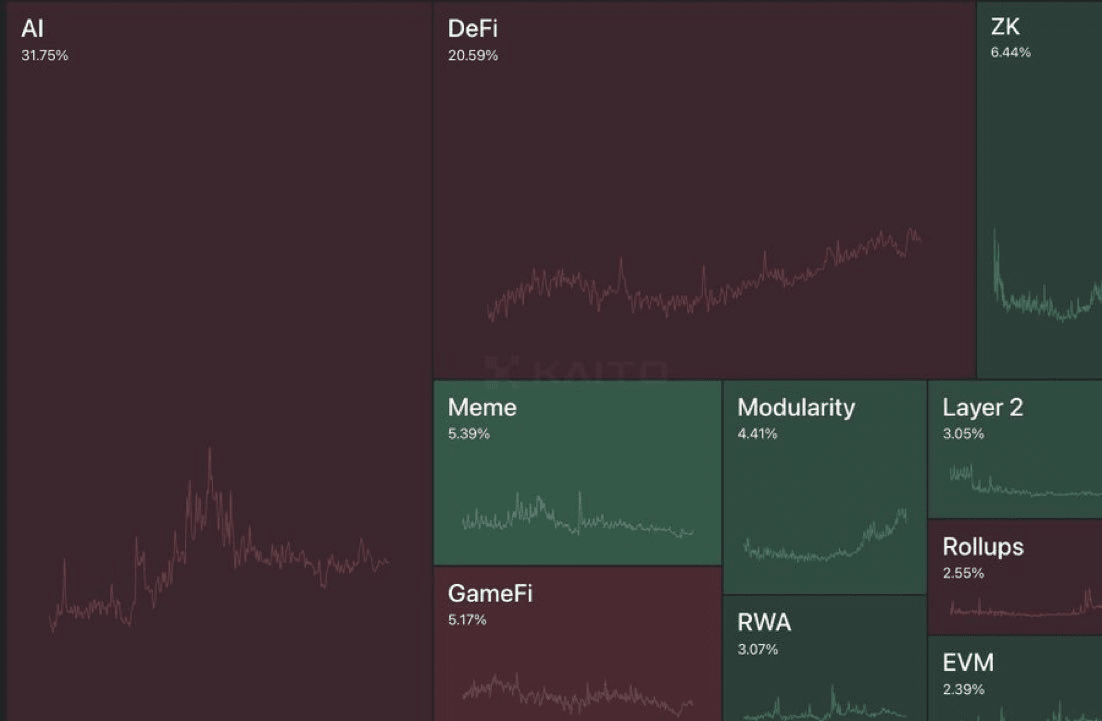
As the ZK ecosystem expands, the demand for generating computation-intensive proofs has reached a critical turning point. To meet this demand, a new specialized infrastructure layer is needed. The Succinct Prover Network has emerged: a decentralized market for generating ZK based on Ethereum. It adopts a vApp architecture, combining high performance with verifiable security. At the core of this system is the $PROVE token, which acts as the economic engine driving this new digital commodity market through payments, security, and incentives.
This article will comprehensively explore the architecture of the Succinct Prover Network, the core functions of $PROVE, its token economics, and the market dynamics of its ecosystem.
The launch of the Succinct Network mainnet and the initial public trading of the $PROVE token are imminent. This is no secret, and below we will delve into the specifics and the value it brings to stakeholders.
2. Network architecture
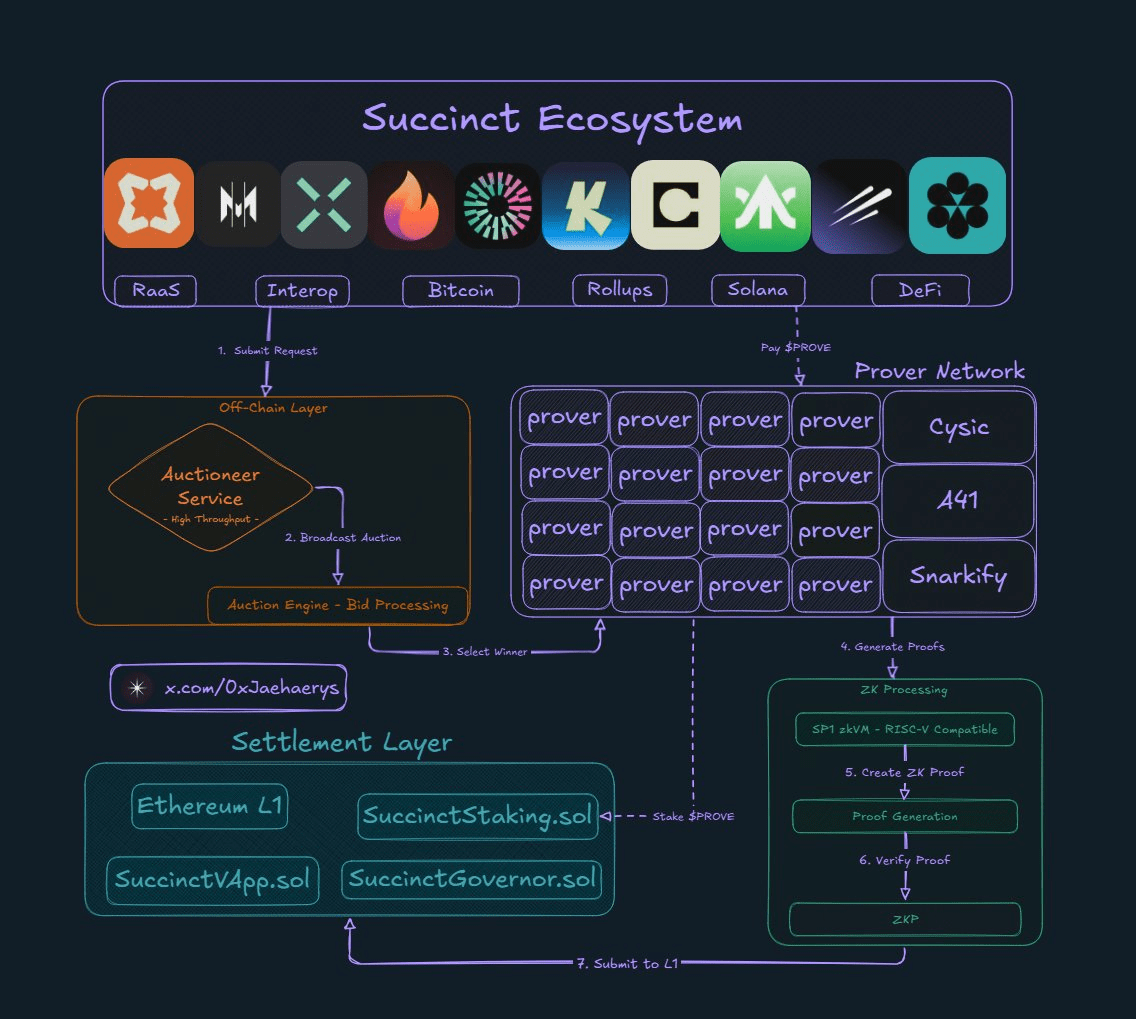
The architecture of the Succinct Prover Network is based on Ethereum's vApp. This model is designed to provide users with the high-performance experience of traditional web applications while retaining the security and trust guarantees of decentralized protocols.
Separation of execution and settlement
The core of the vApp architecture lies in separating execution from settlement, similar to the design pattern of Layer 2 sequencers.
Off-chain execution is handled by a high-performance service that manages the auction process, proof allocation, and user interaction in real time. This allows users to submit requests and receive updates without worrying about the delays of block confirmations.
On-chain settlement occurs on the Ethereum mainnet, with the mainnet using ZK to periodically verify the correctness of the network state and off-chain operations.
This hybrid approach ensures that user funds are always protected by Ethereum contracts and can be directly withdrawn, while market operations remain fast and efficient.
Key components
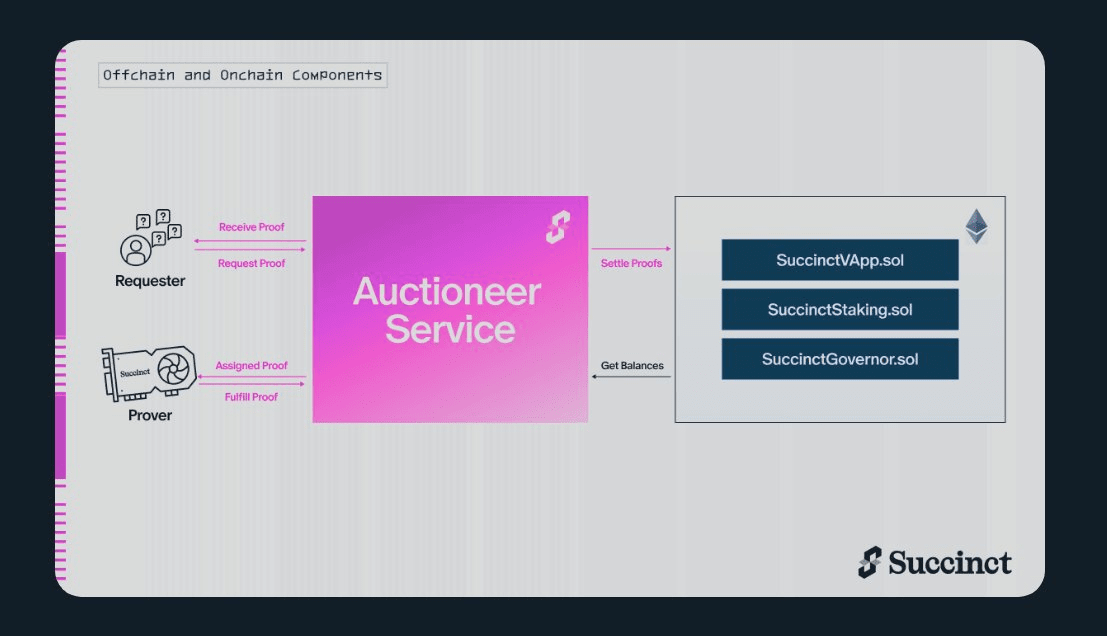
The network consists of two main components:
Off-chain auction service: This is the main off-chain entity responsible for matching user requests with provers. It receives proof requests, collects bids, runs the auctions, and allocates work. Users interact directly with this service via RPC calls for a real-time experience.
On-chain settlement contracts: A set of smart contracts deployed on Ethereum, including SuccinctVApp.sol, SuccinctStaking.sol, and SuccinctGovernor.sol, serving as trust anchors for the network. These contracts are responsible for settling the state roots and ZK proofs regularly submitted by the auctioneers, ensuring the integrity of the network.
Verifiable database
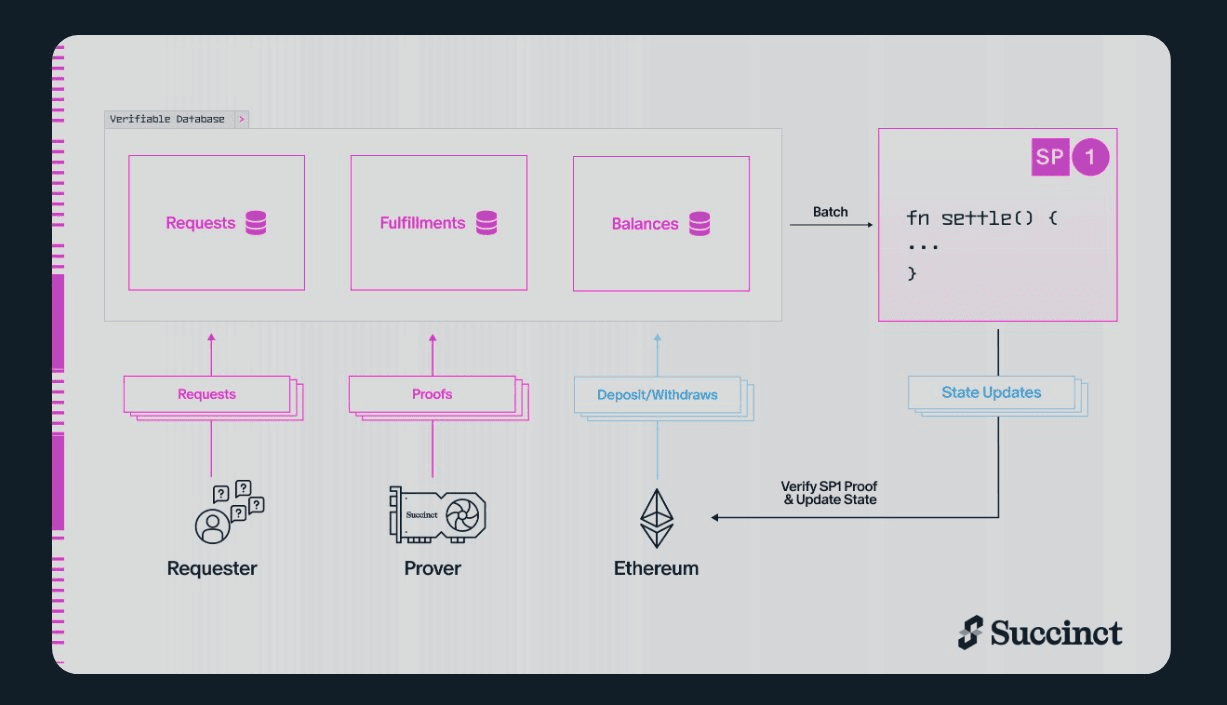
To ensure the integrity of off-chain operations, the auction service is built on a verifiable database. This backend architecture allows anyone to independently verify all balance updates and proof fulfillment statuses. It includes:
A database that stores user balances, pending requests, and fulfillment statuses. This database supports read and write operations.
A prover based on SP1, used to read the database and calculate the ZK proof for the network's new state. This proof will validate all state transitions, such as balance updates and proof allocations, and will then be settled on Ethereum for public verification.
3. $PROVE token
$PROVE token is an ERC-20 utility token based on Ethereum, serving as the economic lifeblood of the Succinct Prover Network. It is designed with three main functions to facilitate payments, ensure network security, and coordinate the interests of all participants.
Core utility
The utility of the token is reflected in multiple aspects:
Payments: $PROVE is the only payment token in the network. Requesters wishing to obtain proofs for their computations must pay the corresponding fees to provers in $PROVE. This creates a direct and sustained demand for the token.
Security: The network's security is ensured through staking. Provers must stake $PROVE to participate in bidding, ensuring they act in good faith. If a prover acts maliciously or misses a deadline, part of their stake will be forfeited.
Incentives: $PROVE is used to incentivize provers to invest in infrastructure and continuously provide competitive prices.
Token supply and issuance
The initial supply of $PROVE is 1 billion tokens, but there is no fixed cap, as the protocol includes a mechanism for continuous token issuance. The rate of new issuance is not fixed but is controlled by a parameter within the network's decentralized governance system, allowing the community to dynamically adjust incentives as the network evolves.
Staking and delegation
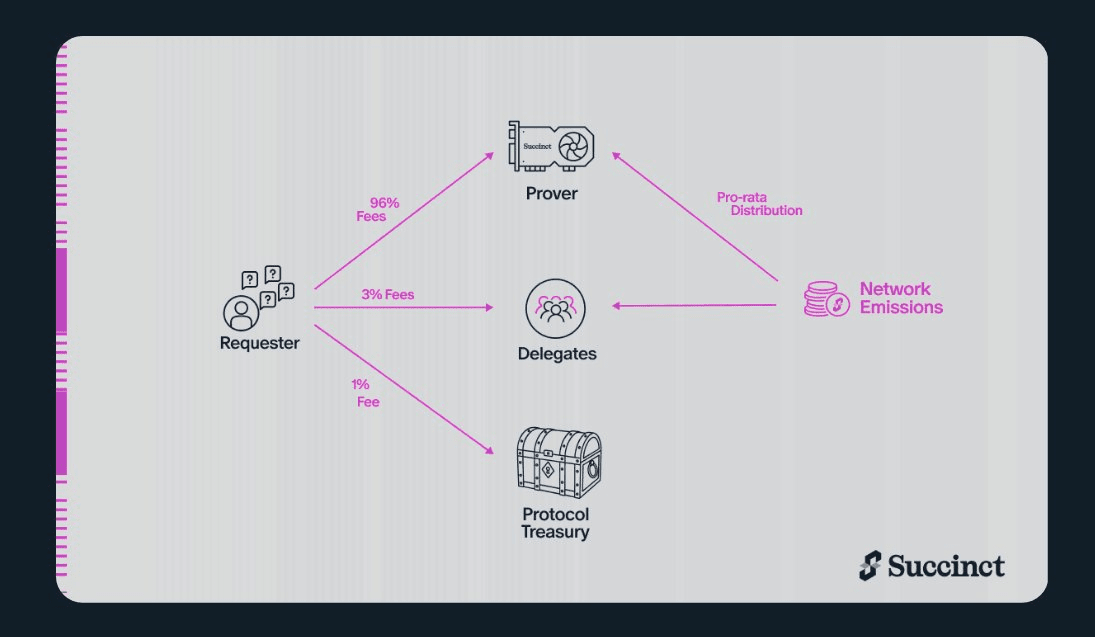
To ensure economic security, any user can stake $PROVE. The system supports two main modes:
Prover staking: Provers stake $PROVE to qualify for participating in auctions and executing proof requests.
Delegation: Any holder of $PROVE can delegate their tokens to a chosen prover. This allows them to contribute to network security and earn a portion of the fees collected by the selected prover without needing to run any hardware themselves. A delegator can only delegate to one prover at a time.
When a proof request is successfully executed, the fees paid by the requester and the tokens issued by the network will be distributed among the winning prover, their delegators, and the protocol treasury. For example, a potential distribution scheme might allocate the majority of the fees to the winning prover, a portion to the delegator for providing security, and a small network fee to the treasury. The network issuance will be proportionally distributed to all stakers (including provers and delegators).
Governance
$PROVE token holders are the ultimate governors of the protocol, with the right to vote on key network parameters. This includes setting network fees, adjusting staking requirements, and deciding on the form of the auction mechanism.
4. Auctions and requests
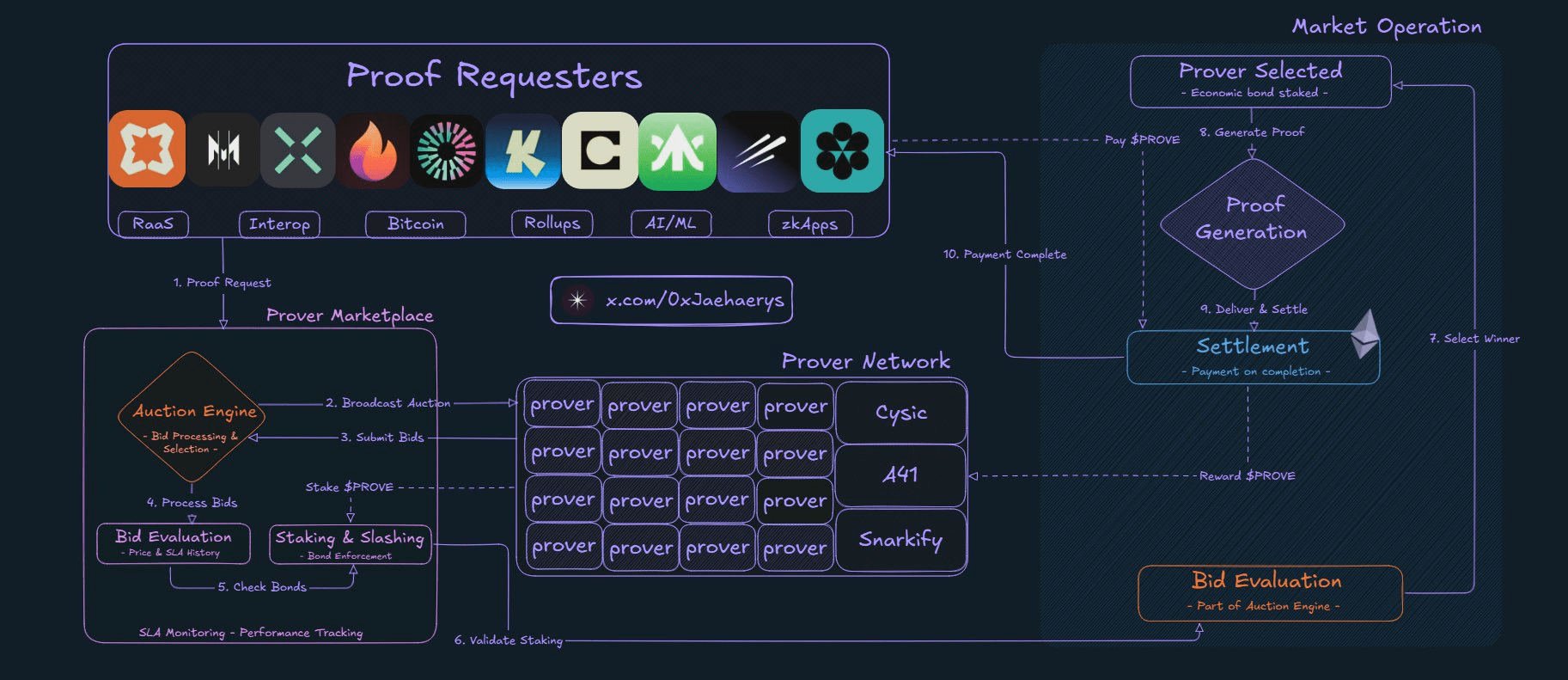
The Succinct Prover Network employs a carefully designed market structure to facilitate price discovery and allocate proof generation tasks to the most efficient provers. The system is built to be flexible and meets a wide range of user needs through different service models.
Auction mechanism
The network adopts real-time bidding to allocate requests. This auction mechanism allows for efficient price discovery with minimal latency and uses $PROVE tokens for payments.
Initial version: The first version of the network employs a simple reverse auction to allocate proof requests to the lowest bidding provers.
Future evolution: Over time, the governance mechanism can transition this approach to a 'proof competition' model. This model aims to distribute rewards to a broader group of provers, thereby increasing decentralization.
The entire auction process is handled by the off-chain auction service, but anyone can independently verify the results using periodically published zero-knowledge proofs on-chain.
User experience
The process of requesting and executing proofs is designed to be simple and secure.
For requesters: Users (such as ZK Rollup operators) can easily request proofs by first sending $PROVE to the auctioneer to pay the fee. They then send proof requests via RPC calls, specifying the program to be proven, the deadline, and the maximum fee they are willing to pay. Off-chain auctioneers will match this request with the lowest-priced qualified provers. Once the proof is completed and submitted, the fee will be transferred, and the entire transaction will be settled on Ethereum through a single ZK proof, allowing requesters to verify if it has been correctly processed.
For provers: Provers compete for the right to execute requests. To qualify for a specific auction, the $PROVE staked by the prover must meet the minimum requirements set by the requester (for example, a request may require 50 $PROVE staked). Qualified provers submit bids to the auctioneer. The prover with the lowest bid wins the auction and gains the proof, which they must complete before the specified deadline. If successful, they will receive payment in the form of $PROVE. If they fail to submit the proof on time, their stake will be slashed.
Minimum staking amount: 1,000 $PROVE (testnet; mainnet TBD)
Service models
The network offers users flexibility through two different service models:
On-demand requests: Users can send requests to the network as needed, which will enter a public auction open to all online provers. This is ideal for users seeking the most competitive prices or applications that occasionally experience high demand.
Off-chain reservations: For users needing stronger reliability guarantees or high-frequency, large-scale demand, the network supports off-chain service level agreements (SLAs) with specific provers. These agreements can whitelist approved provers, granting them exclusive bidding rights. Due to the long-term nature of these agreements, prices may be more favorable.
5. Market dynamics and ecosystem
A successful crypto-economic system requires not only robust technology but also a vibrant ecosystem of participants and a clear strategy to generate network effects. The $PROVE token is at the core of an economic system designed to coordinate rational, independent participants in a thriving market.
Two-sided market
The network establishes a classic two-sided market, a common pattern in the DePIN space. In this case, the coordinated infrastructure is the computing hardware (GPU, FPGA, ASIC) needed to generate ZK. The two parties are:
Demand side (requesters): This group consists of blockchain protocols, applications, and developers who need ZK to conduct business. These requesters create organic demand for network services, flowing into the ecosystem in the form of payments made with $PROVE.
Supply side (provers): This group consists of individuals and professional entities that own and operate the computing hardware necessary for generating ZK. They invest in capital-intensive infrastructure to compete in providing services, earning fees priced in $PROVE and network rewards.
Ecosystem security
For emerging markets, one of the biggest challenges is the 'cold start' problem: without demand, provers won't join; without a reliable supply of provers, requesters won't join either. Succinct Labs addresses this issue by focusing on ensuring market demand even before the mainnet launch.
The project has established partnerships with many leading projects in the Web3 space, ensuring immediate and significant demand from day one.
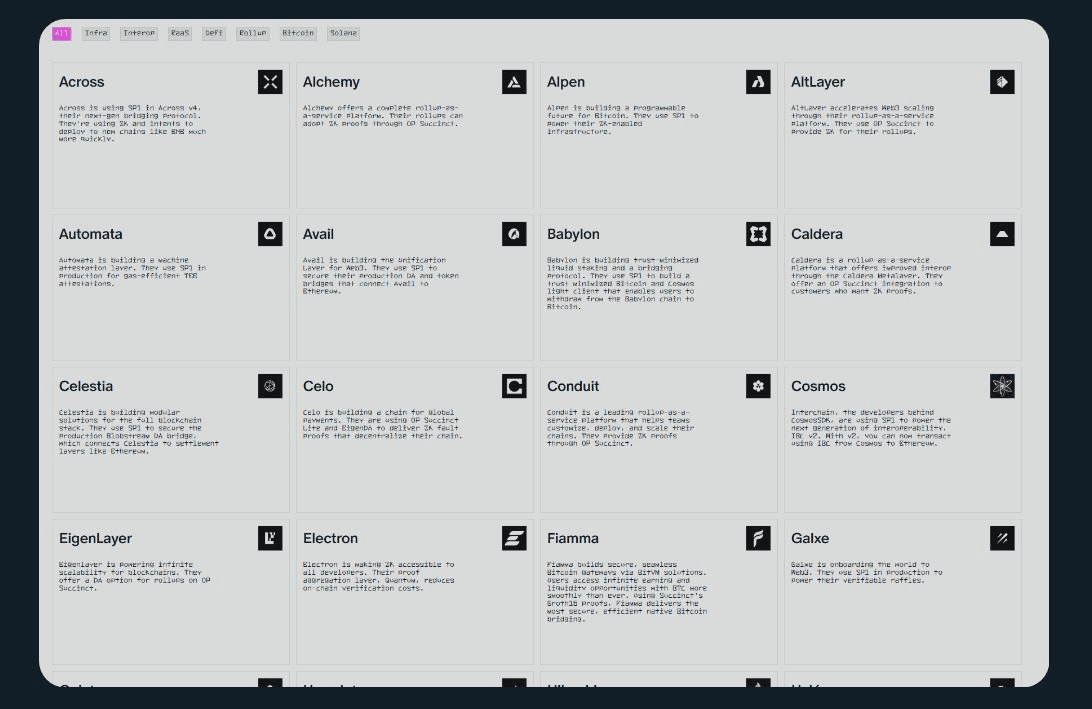
This move reduces the economic risks for provers and ensures that the $PROVE token has immediate trading velocity from the start, supporting the entire economic model.
Ultimately, the Succinct Prover Network is based on a simple premise: the future of computation is verifiable. The $PROVE token is a key mechanism for realizing this future, transforming cryptographic proofs from a niche technology into a liquid digital commodity accessible to everyone.
Related reading: The king of ZKVM? An analysis of the $55 million funding for Succinct and a participation tutorial.



